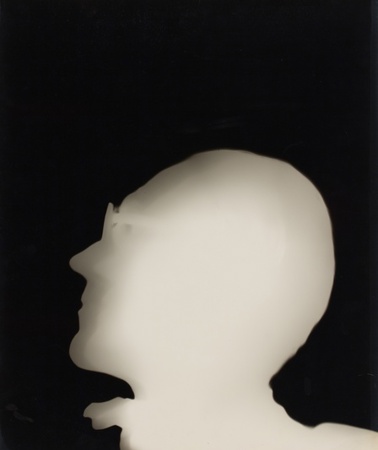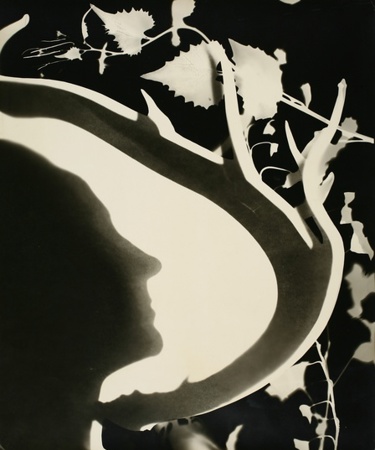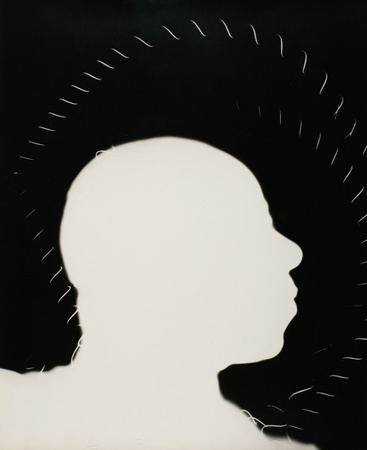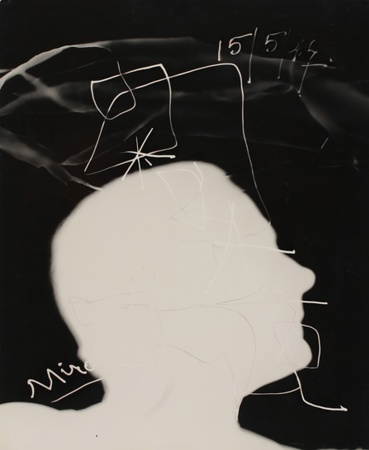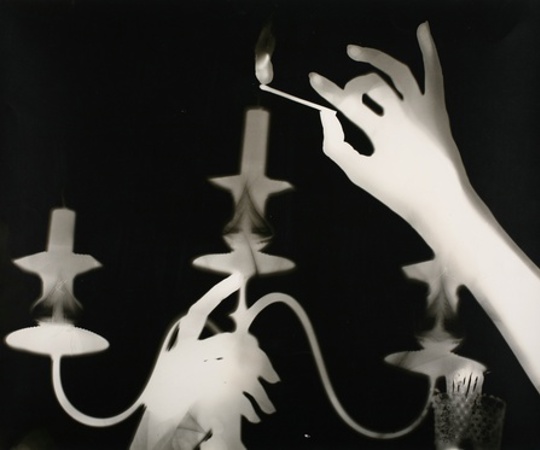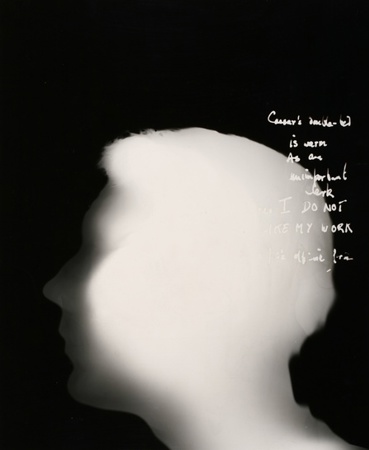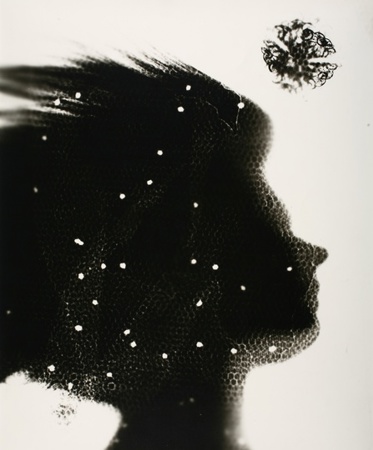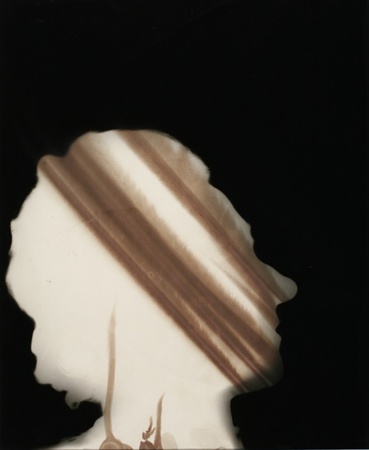Len Lye’s shadowgraph portraits
The 48 shadowgraphs Len Lye produced during 1947 are a singular occurrence in the history of photography. No other body of works gathers together as an eclectic group of sitters to physically pose for photographs, nor does any other body of work rival this breadth of camera-less portraiture. Various threads tie the collection together. Beyond the genre, medium and layout, Lye’s overarching creative interests find their way in through both the layers of symbolism and the camera-less experimentations. His evolving thoughts and ideas mark a discernible path through these experimentations. The nature of the medium means everything represented on the exposed print is indexical of not only the very real occurrence in the studio but also of deeper meanings implied through intentionally illusory arrangements. This collection of photograms emerges as extraordinarily potent in the very fundamental elements of photography, making it a necessary destination in the history of photography.
The portrait, an artistic endeavour to represent someone’s likeness, is one of the longest standing genres in art. Photography seems to be portraiture’s most capable medium because it can acutely reproduce one’s appearance by capturing the light that physically touched it (true to both camera and camera-less photography). The portrait genre is typically fleshed out with symbols and motifs that demonstrate the subject’s identity, occupation, or interests for example. Such elements are easier to add in mediums less tied to reality, yet the photographer’s point-of-view and its representative power allow the very staging of reality to help infer a persons’ identity. Lye’s shadowgraphs generally succeed in portraiture’s traditional requirement to reproduce one’s likeness, where the hard silhouettes record individual identity by emphasising the curvature of facial features. It then becomes less important for someone looking at a portrait to instantly recognise who the figure is and more important for the portrait to intimately build a sense of the figure.
The silhouette of Le Corbusier, for example, might be recognisable to those with a particular interest in modernist architecture. The iconicity of his glasses and bowtie along with a strong nose and jaw would be of use to those who already know him. However, those who do not can still gain a sense of the figure as they become intimately familiar with the lines of his face the more they look. Yet, in many other portraits as well as Corbusier’s, Lye brings in referents and symbols of his career in architecture through the repeating geometric industrial-looking forms of match-stick blinds and a grate. Someone unknowing of Corbusier’s legacy can recognise that he works within the realms of logic, construction and creativity. His jutted chin further reveals he is proud of his work and perhaps stands at the forefront of his craft.
Using the same method of deduction, Georgia O’Keeffe’s silhouettes reveal a proud woman who is associated with organic forms and the natural world, the antlers in her photogram appearing expressive like a paintbrush. One can read Baby Dodds’ silhouette as a man with rhythmic talents with how the evenly spaced musical notations of the circle around his head. W. H. Auden’s portraits point more clearly to his identity with a verse from his famous poem The Fall of Rome written across the frame. However, the more intimate details of his handwriting and the contours of his face make it seems as though we know him more personally. Auden’s and Joan Miró’s identities are rather bluntly revealed through their signatures, although they nevertheless point towards two men who seem to sign off their creations on the regular. The camera-less process indeed detracts any visual definition of the figures apart from their silhouettes. Yet, it is this very process that allows for Lye to build up their personas through layers of referents.
The photogram in itself is perhaps the fundamental state of photography. In no other format is the photography’s methodology so explicit in the final image, where light and chemicals react without the mediation of a camera lens. The subjects of photograms, therefore, leave a more potent trace of their presence for they did more than merely sit in front of a lens, they made contact with the physical photograph. As the light hits the exposed sections of the chemically treated paper it not only the moment of exposure but the physical contact of the subject which is captured and soon preserved when placed in the fixative. It is this raw physicality of a photogram that pushes photography’s perpetuity beyond what can be produced with a camera. The unabridged evidence of that-has-been provides photograms with a more tangible essence of the subject long after the exposure. The moment of contact has been frozen and pulled into the future. Since the First World War, many photographers have explored and innovated the representative possibilities of this type of photography. Some have even tested the limitations of lens photography in this other realm, exploring if and how movement and elapsing time can be captured and represented.
Lye’s shadowgraphs follow a similar experimental approach, beginning to push the boundaries of what a photogram can depict, or more accurately what it can represent. In Candlestick, he attempts to depict a live flame burning at the end of a matchstick, which already seems unfeasible. The light emitted by a flame would interrupt the camera-less process, plus the sentient nature of fire prevents it from lying flat against the paper. Lye no doubt saw this as a worthy challenge, figuring the representation of the flame is the best route. The direct reference to what-has-been in a shadowgraph allows the film material he uses to capably represent the presence of a live flame, even if the cleanness of the shape pulls away from a full illusion.
The endeavour becomes even more interesting in two of W. H. Auden’s portraits. Lye has purposefully left sections underneath the silhouettes where it appears he has once again tried to represent a live flame. The strange smoky shadows cast across the length of the shadowgraph like candlelight. Such a symbol fits with Auden’s portraits, calling to mind the romantic notion of a poet writing under candle-light, the burning fire of creative inspiration, or a larger metaphor for the extinguished flame of an empire as he writes about in his poem The Fall of Rome which is superimposed over his silhouette. Nevertheless, this shadowy form demonstrates a new approach to representing a flame. Judging by their more unpredictable forms, it is possible he used an actual flame this time around, although how he could have done this is hard to tell. Perhaps, he placed a translucent layer on top of the light-sensitive paper to diffuse the light. More likely, he used another stand-in for a live flame, some object he could manipulate to disperse across the canvas during the time of exposure.
Another feat he attempted was the presence of movement. Although a sense of movement is a fairly common element to capture with a camera through motion blur or frozen moments of suspension, it becomes almost impossible to capture with the photogram’s prolonged exposure time and the necessity of the subject to remain in contact with the paper. So instead, he depicts it through illusion. Althea’s hair electrically flows behind her in each of her four portraits, instantly suggesting gale-force winds although we know there would have been no wind in the studio. Instead, Lye arranged her hair, or what is likely a wig, to appear in the midst of the action. He then placed other signifiers in the portraits like leaves and energetic bundles of debris, skewed to appear as if rolling through space. The camera-less process allows for this indexicality: the ability to indirectly refer to something else. One can see movement in the images without it actually being there. One can interpret the scene of a woman walking through the park during gale-force wind as leaves fly through the air, even if the reality is a static woman, a wig and cut out leaf patterns.
Lye also attempted to represent movement in Nina Bull’s portraits, although here it is more allegorical. As a neuroscientist and psychologist, she largely influenced Lye’s understanding of brain functions with how the mind receives information and sends it to the body. He was especially fascinated by how unconscious information could be pulled from storage in the brain and intuitively carried out by the physical body. He visualises this process through the dark stains that bleed across Bull’s silhouette, banding her forehead and climbing up from her neck. Lye has represented the movement of information that in reality happens in an instant, but in the shadowgraphs can be frozen and preserved.
There are many more fascinating elements to the 1947 shadowgraphs. The array of subjects can be grouped in various ways, as can the way Lye has chosen to represent them. Across the shadowgraphs, he plays with the duality of life and death, the birth cycle, gender dynamics, creativity, and the unconscious. In line with his filmmaking talents, he becomes extremely innovative in how he manipulates various materials to represent something new, and although his career is full of ideas and artworks that bridge across mediums, these shadowgraphs are entirely singular within his legacy. They would not produce the same indexicality if completed in a painting or created in batik, and although he spent his whole career exploring ideas of movement, the unconscious, organic and mechanical processes, the camera-less process allowed him to communicate them through new innovative methods.
Lye would soon delve deeper into movement and mechanical processes with kinetic sculpture. However, these shadowgraphs are his only work that so explicitly reveals their method of production as an integral part of the work. This is the very nature of photograms, although the 1947 shadowgraphs nevertheless stand out for the individualistic ways Lye utilised the medium. Human forms are no stranger to avant-garde photograms, although no one else has committed to a gallery of portraits in which each portrait aims to represent the essence of its individual subject. Lye does all this while experimenting and pushing the boundaries of what can be achieved without a camera, therefore making the 1947 collection of shadowgraphs a necessary milestone in both Lye’s legacy and in the history of photography.
